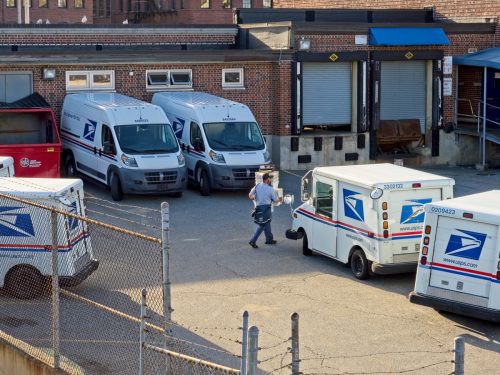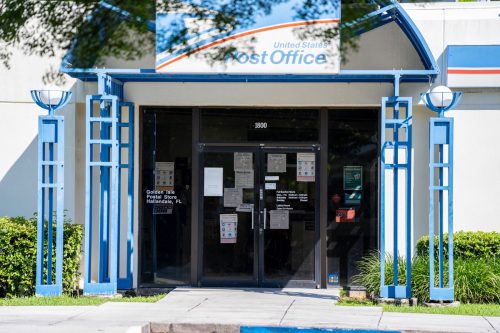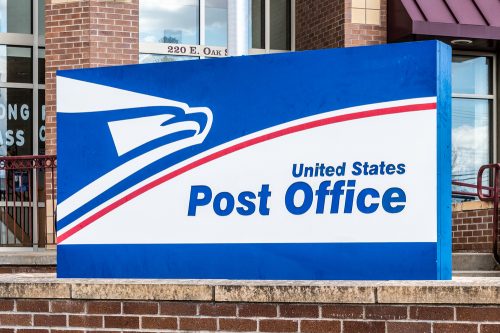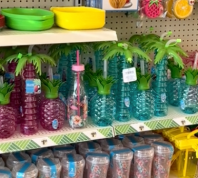USPS Temporarily Suspending Services in These Places
The agency has added new closures to its list of current suspensions.

The U.S. Postal Service (USPS) is serious about making sure people's mail and packages get to them on time—especially during the holidays. But there's one thing they're even more serious about: doing so safely. The agency has already warned customers that they might face delivery delays during the winter if they don't do their part to keep carriers safe. But when it comes to weather hazards and other safety concerns, you might not always be able to avoid delays and closures. Now, the USPS is temporarily suspending services in more places, along with some ongoing closures. Read on for the latest updates.
RELATED: USPS Is Starting the New Year With All These Changes to Your Mail.
The Postal Service just closed a post office in Illinois.

The USPS last updated its Service Alerts website on Dec. 11 to inform Illinois residents about a closure that may affect them. According to the alert, the post office at 34 N. Main Street in Saint Augustine, Illinois, is currently not open to customers. The facility has been "temporarily closed due to safety concerns," the Postal Service stated.
The agency did not elaborate on what those concerns are. Best Life reached out to the USPS to get more information, and we will update this story with its response.
During the Saint Augustine Post Office closure, customers are being directed to a nearby facility for services.
"Retail and delivery operations have been relocated to Abingdon Post Office," the agency added in its alert. "PO Box mail and previously attempted mail or packages can [also] be picked up at the Abingdon Post Office."
RELATED: USPS Warns "Mail Service Could Be Halted"—Even If You're Following the Rules.
A facility in Vermont was shuttered for similar reasons.

Just a few days prior, the Postal Service released an alert about a suspension in Vermont. On Dec. 8, the USPS announced that the Montpelier Post Office at 87 State Street is now "temporarily closed due to safety issues." But unlike the Illinois closure, local news reports provide some answers.
According to the local news outlet NBC5, the Montpelier Post Office first closed back in July after "catastrophic flooding" in the state. Over the last five months, postal workers had been operating out of a mobile truck in the parking lot of the facility. But that just closed as well.
During a news conference, Vermont Gov. Phil Scott said he doesn't know the extent of the repair work on the post office and has not gotten any insight from the USPS on its long-term plans for the Montpelier facility, NBC5 reported.
"I don't know what to make of it, to be honest with you," Scott said. "This isn't some small town that lost a few post office boxes, this is our capital city. They should be paying attention to this, I believe, but they don't appear to be."
RELATED: USPS Issues New Warning About Sending "Valuables" in the Mail.
The USPS says it might be some time before the Montpelier Post Office is able to reopen.

Scott said that the Postal Service has yet to respond to a letter from Vermont's Federal Designation about the future of the city's post office, NBC5 reported. Currently, residents are being directed to travel to the Barre Post Office for mail and retail services, according to the agency's Service Alerts website. The two facilities are roughly 10 miles apart.
When Best Life reached out to the USPS about the Montpelier Post Office closure, spokesperson Steve Doherty indicated that this is not meant to be a permanent solution.
"While operations have temporarily been relocated to our Barre office, the Postal Service is actively searching for a suitable location to reestablish a retail presence in Montpelier," he said.
Still, Doherty acknowledged that it might be some time before the original Montpelier Post Office can be reopened, based on the damage that occurred from the "devastating flooding" this past summer.
"We're told that the former site may not be available for re-occupancy until late 2025," he shared.
Facility damage has also forced the agency to close other locations.

The safety of post office buildings is crucial for the Postal Service to continue regular operations. In a previous round of closures, the USPS had to close facilities in three different states for damage: Alaska, Washington, and Oregon.
The Alaska closure affected the Little Diomede Post Office over what the USPS described as "facility damage." But a USPS spokesperson told Best Life that a new post office has since opened in this area, and that "customers are receiving their mail."
Meanwhile, weather-related hazards resulted in the Washington and Oregon closures. In Washington, the Hamilton Post Office was "temporarily closed due to heavy rains and storm damage," according to the Service Alerts website. Kim Frum, USPS strategic communications specialist, previously confirmed to Best Life that this facility reopened on Dec. 7.
The Oregon facility appears to still be closed, however. This closure affected the Wheeler Post Office due to "storm damage from recent heavy rainfall and flooding," Frum explained in a prior statement. During this closure, customers are being directed to the nearby Nehalem Post Office to pick up mail and conduct retail transactions, according to a local press release from the USPS.
"We apologize for this inconvenience to our customers and plan to resume operations at the Wheeler Post Office as soon as it is safe to do so," the agency stated in its release.
RELATED: For more up-to-date information, sign up for our daily newsletter.





















